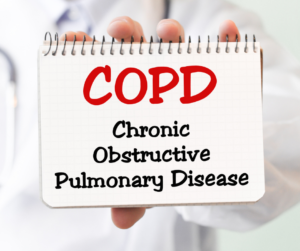Newly Diagnosed with COPD?
 Step 1: Learn about COPD.
Step 1: Learn about COPD.
COPD stands for chronic obstructive pulmonary disease and refers to having emphysema and/or chronic bronchitis. You will feel more in control when you learn how living with COPD affects your breathing and what steps you can take to feel better.
Step 2: Recognize what makes your symptoms worse.
COPD is progressive and may worsen over time. People living with COPD can experience an exacerbation or flare-up that may require medical attention. Exacerbations can be caused by COPD “triggers” like tobacco smoke, colds, or respiratory infections. Symptoms of a COPD flare-up include:
- Worsening shortness of breath
- Increased cough
- Fatigue, or loss of energy
- Change in the color, thickness, or amount of sputum (mucus or phlegm)
These symptoms are different than what you experience on a day-to-day basis. Work with your provider to develop a plan that outlines steps to follow when your COPD is under control, getting worse, or when your symptoms are so severe that you require immediate medical attention.
Step 3: Follow your treatment plan.
There is not a “one size fits all” treatment for COPD so work with your healthcare provider to create a plan that helps relieve your symptoms. Discuss with your healthcare provider topics such as medications, pulmonary rehabilitation, oxygen therapy, tobacco cessation and interventional or surgical treatments.
Step 4: Understand ways to manage your COPD.
There is no cure for COPD, but treatment and management can help slow COPD progression and control symptoms, so you feel better and able to spend more time doing what you enjoy.
- Talk to your provider and attend scheduled appointments.
- Take your medication as prescribed.
- If you smoke or vape, we can help you quit.
- Talk to your provider about increasing your physical activity.
- Discuss with your provider or a dietitian your concerns about weight and nutrition.
- Talk with your loved ones about planning for the future.
- Learn breathing techniques like belly and pursed lip breathing.
- Talk to your provider about vaccines that protect you against infectious respiratory diseases like COVID-19, flu, and pneumonia.
Step 5: Find support.
You are not alone. Help and support are available from the American Lung Association:
- Join the Patient & Caregiver Network
- Attend a Better Breathers Club support group
- Register for an online support community
- Taking care of your emotional health is as important as taking care of your physical health. At times, most people living with a chronic health condition like COPD experience sadness, fear, and worry. If you find these feelings are not going away and the changes in your mood are affecting your ability to keep up with daily activities and things you enjoy, talk to your healthcare provider.
- Talk to a registered nurse, respiratory therapist, or tobacco cessation specialist at the Lung Helpline.
More frequent questions the Lung HelpLine receives about COPD are questions about:
- Managing COPD
- Quitting smoking including vaping and e-cigarettes
- Oxygen therapy
- Financial assistance programs
- And more
